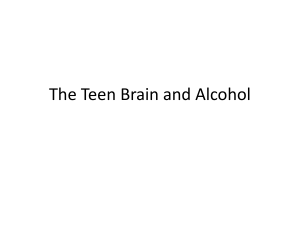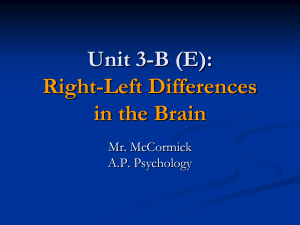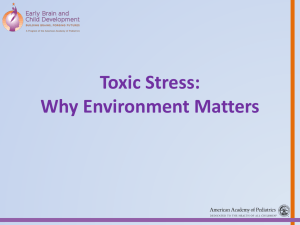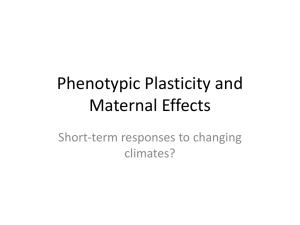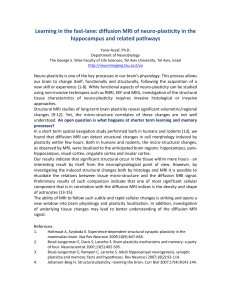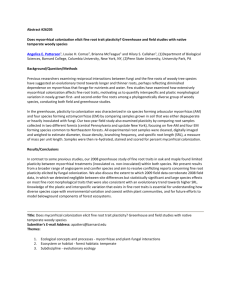Evo-Panel Article Summary_f11
advertisement
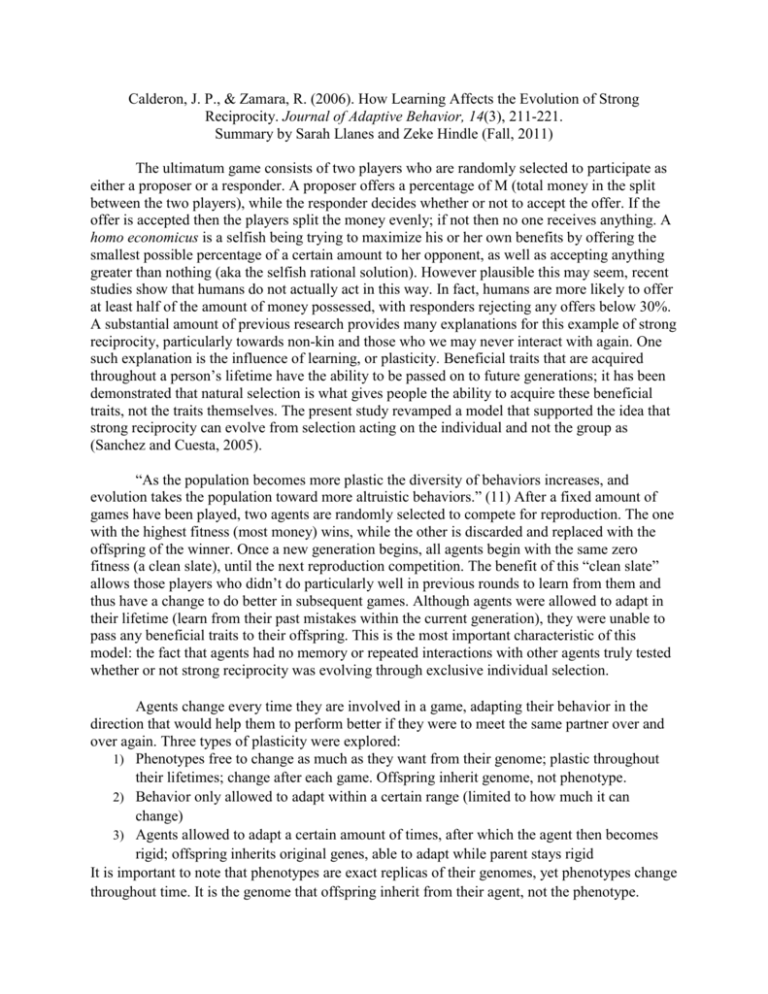
Calderon, J. P., & Zamara, R. (2006). How Learning Affects the Evolution of Strong Reciprocity. Journal of Adaptive Behavior, 14(3), 211-221. Summary by Sarah Llanes and Zeke Hindle (Fall, 2011) The ultimatum game consists of two players who are randomly selected to participate as either a proposer or a responder. A proposer offers a percentage of M (total money in the split between the two players), while the responder decides whether or not to accept the offer. If the offer is accepted then the players split the money evenly; if not then no one receives anything. A homo economicus is a selfish being trying to maximize his or her own benefits by offering the smallest possible percentage of a certain amount to her opponent, as well as accepting anything greater than nothing (aka the selfish rational solution). However plausible this may seem, recent studies show that humans do not actually act in this way. In fact, humans are more likely to offer at least half of the amount of money possessed, with responders rejecting any offers below 30%. A substantial amount of previous research provides many explanations for this example of strong reciprocity, particularly towards non-kin and those who we may never interact with again. One such explanation is the influence of learning, or plasticity. Beneficial traits that are acquired throughout a person’s lifetime have the ability to be passed on to future generations; it has been demonstrated that natural selection is what gives people the ability to acquire these beneficial traits, not the traits themselves. The present study revamped a model that supported the idea that strong reciprocity can evolve from selection acting on the individual and not the group as (Sanchez and Cuesta, 2005). “As the population becomes more plastic the diversity of behaviors increases, and evolution takes the population toward more altruistic behaviors.” (11) After a fixed amount of games have been played, two agents are randomly selected to compete for reproduction. The one with the highest fitness (most money) wins, while the other is discarded and replaced with the offspring of the winner. Once a new generation begins, all agents begin with the same zero fitness (a clean slate), until the next reproduction competition. The benefit of this “clean slate” allows those players who didn’t do particularly well in previous rounds to learn from them and thus have a change to do better in subsequent games. Although agents were allowed to adapt in their lifetime (learn from their past mistakes within the current generation), they were unable to pass any beneficial traits to their offspring. This is the most important characteristic of this model: the fact that agents had no memory or repeated interactions with other agents truly tested whether or not strong reciprocity was evolving through exclusive individual selection. Agents change every time they are involved in a game, adapting their behavior in the direction that would help them to perform better if they were to meet the same partner over and over again. Three types of plasticity were explored: 1) Phenotypes free to change as much as they want from their genome; plastic throughout their lifetimes; change after each game. Offspring inherit genome, not phenotype. 2) Behavior only allowed to adapt within a certain range (limited to how much it can change) 3) Agents allowed to adapt a certain amount of times, after which the agent then becomes rigid; offspring inherits original genes, able to adapt while parent stays rigid It is important to note that phenotypes are exact replicas of their genomes, yet phenotypes change throughout time. It is the genome that offspring inherit from their agent, not the phenotype. Results demonstrated that rigid agents not only do in fact converge to the rational solution predicted by game theory, but also that a population initially diverse in behaviors will eventually converge to selfish behaviors. This solution is not entirely stable, though, for the offers and acceptances fluctuate throughout each generation (or the evolutionary process). Results also showed that the behavior of those agents who were plastic throughout their lifetimes no longer converged to the rational solution--learned behavior differed from what was innate in them. For example, they learned to accept (want) more than what they would initially be content with. This demonstrates that plasticity does indeed cause the spread of learnt behaviors. Furthermore, a positive interaction was found between adaptability and the average offers and acceptance thresholds: as adaptability for agents increases, so does the average offers and acceptance thresholds of the population. The present study concludes that plasticity is in fact beneficial in the evolution of strong reciprocity. Not only does it increase the diversity of behaviors within a population, but it is also evolutionary stable (does not disappear if genetically determined). Outline for Article I. Definitions of terms for this specific article and experiment format A. Phenotypic plasticity, lifetime adaptations, ontogenic adaptations, learning 1. The aforementioned terms are defined as “changes that an individual undergoes within his/her lifetime and that will not going to be [sic] inherited directly by the offspring”. B. Strong Reciprocity 1. The evolved behavior of humans to “cooperate with non-kin, including people that they will never meet again, and punish non-cooperators even at a personal cost”. C. Ultimatum Game 1. Two players are randomly selected to participate on being the proposer and one being the responder, the participants do not know each other, and only play with each other once. 2. Proposer offers a percentage of M (total money in the split between the two players). 3. Responder decides whether or not to accept the offer. 4. If the offer is accepted then the players split the money evenly, if not then no one receives anything. D. Homo Economicus 1. “A self-interested being who will try to maximize his or her own monetary utility”. 2. offer the smallest percentage of M and will accept anything above the zero value II. III. 3. However, many studies have shown that humans do not act in the aforementioned manner Introduction A. Previous Literature Findings 1. Studies (Bethwaite and Tompkinson, 1996; Fehr and Schmidt, 1999) show that strong reciprocity is found in the ultimatum game and “preferences [potentially are] based on a utility function other than maximizing payoff”. 2. The Sanchez and Cuesta’s (2005) agent-based evolutionary game theory model predicts the emergence of strong reciprocity from selection acting on the individual and not the group, in addition the appearance of altruistic behaviors is found regardless of repeated interactions, reputation, or personal gains. Model A. The model formed by the authors/experiments was similar to the model implemented by Sanchez and Cuesta (2005), however the agents and genetic algorithim was altered to allow for plasticity. B. Rigid Agents 1. (Go) - Indicates amount of money affered by proposer. 2. (Gr) - Indicates amount of money accepted by responder. 3. [0, M] – Range of integer values of money. 4. Genes are randomly selected forcing the behavior of the agent, hence the term “Rigid Agent”. C. Genetic Alogorithim 1. Two agents randomly selected, and the one with the higher fitness (more relative money) is replicated (offspring) while the other (less relative money) is discarded and leaves the game. 2. After each reproduction, “the fitness of all agents is reset to 0”, and then players continue to play the ultimatum game as defined by the above rules. D. Plastic Agents 1. These agents are allowed the ability to adapt during their lifetimes “without directly passing this adaptation on to their offspring”. 2. The offspring only inherit the genome and not the phenome. 3. “Agents change every time they are involved in a game, adapting their behavior in the direction that would help them to perform better if they were to meet the same partner over and over again”. a. Type 1 Plasticity 1. Agents may freely adapt during their lifetimes. b. Type 2 Plasticity 1. Agents only allowed to adapt within a certain range. c. Type 3 Plasticity 1. Agent is allowed to adapt a given number of times [An] and then becomes rigid. 2. Offspring follows same limitations. d. Inherited Plasticity IV. V. Results A. Rigid Agents 1. Results converge “to the rational solution predicted by game theory” meaning that the agents proposed very little and willing to accept almost anything. B. Plastic Agents 1. Type 1 Plasticity a. Plasticity causes the spread of learnt behaviors. 2. Influence of Plasticity Types 2 and 3 a. As adaptablity of the agents increases (Am) the average offers and acceptance thresholds increase. b. As number of games before a given agent becomes rigid (An) increases, the offers made are more generous and thresholds less strict. 3. Plasticity as an Evolutionarily Stable Strategy Discussion and Conclusion A. Author Notes 1. Strong Reciprocity can evolve from selection acting on the individual and not the group as previously thought before the research of Sanchez and Cuesta (2005); reputations are irrelavent 2. Learning can be both beneficial or detraimental to the individual and offspring and could entail an evolutionary trade-off. 3. Costs of plasticity a. Stochasticity b. Time-wasting cost due to the learning process. 4. Benefits of plasticity a. Takes place within the lifetime of agent. b. Might be evolutionarily stable. c. Increases diversity of behaviors and genetic diversity, hence the level of cooperation amongst group members of the population. d. Changes overall (average) behavior of population from selfish to altruistic in nature. 5. Conclusion 1. “Plasticity is evolutionarily stable as (depending on the mechanism by which it is passed on to offspring) it does not disappear from the population if it is genetically determined”. Test Questions 1) Sanchez and Cuesta’s Model of evolutionary game theory (2005) predicts the emergence of strong reciprocity based upon selection acting on: a) the individual b) the group c) both a and b 2) Over time plasticity will evolve behaviors that can be described as: a) selfish b) altruistic c) destructive d) both a and b 3) By definition, strong reciprocity takes into account all of the following except: a) cooperation with kin b) cooperation with non-kin c) cooperation with people that will never interact again d) cooperation even at personal cost 4) Plasticity can be defined as changes that an individual undergoes within his/her lifetime that will be directly inherited by the offspring of said individual. T or F 5) Altruistic punishment is positively correlated with the evolution of plasticity and strong reciprocity. T or F 6) The evolutionary costs of plasticity are higher than the benefits of plasticity that’s why we’re are all selfish and mean people. T or F Answer Key A B B T T F
